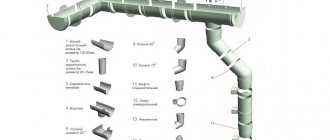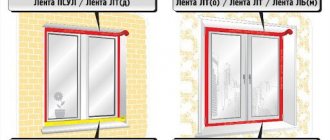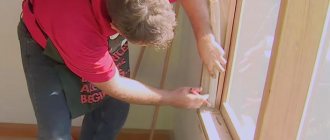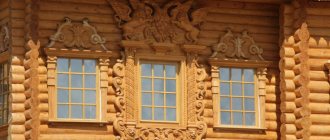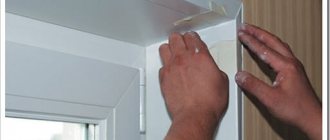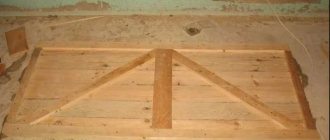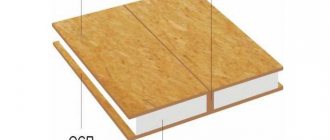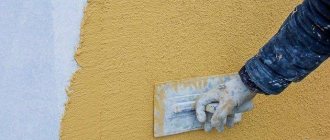Types of tides for windows
Any windows from the outside are equipped with a flashing - this is a special board mounted at the bottom of the window opening. It needs to allow rain or melt water to flow down it. This is probably why this part is sometimes called drainage.
Installing window sills is the final stage of proper installation
Window sills can be:
- Plastic.
- Metal; galvanized steel, coated: polyester;
- plastisol;
- metal paint.
If you install the window sill correctly, the wall will not be damp
Currently, external concrete castings are almost never done. Or rather, they are made, but they are still covered with either plastic or metal. Concrete slopes can, of course, be whitewashed, and this was once done. But today this type of window decoration is very rare.
If we talk about the exotic, we can recall stone tides. They are made from polished granite or marble. They certainly look great, they don’t make any noise, and you can only break them with a sledgehammer. But their cost is not for every wallet.
Stone tides - look gorgeous
There is another interesting type of external window sills - from facade tiles. It works great with any window - both wooden and plastic. If your basement or the whole house is decorated with similar tiles, it will look very “on theme” on the windows. At the same time, the house looks like a single ensemble. Such slopes are made extremely simply: the tiles are cut so that they protrude 1 cm beyond the walls, and the desired slope is formed using a cement-sand mortar. The seams can be sealed with cement laitance, or a hydrophobic impregnation can be used. It’s just better to install such slopes before finishing the exterior walls.
Flashings from facade tiles - easy to do with your own hands
Although window slopes come in different materials, the vast majority of homeowners settle on two: plastic or metal. Each of them has its own pros and cons, and we’ll talk about them in more detail, as well as how to install window sills.
Manufacturing materials
Products may not be made from all materials. The result of using the wrong material may be the formation of rust on the product and dark stains on the walls.
Window sills can be made of galvanized steel, polyvinyl chloride, tin and other materials
To avoid such troubles and unjustified financial expenses, it is enough to understand which materials are suitable for the manufacture and installation of window sills. Window sills are made from galvanized steel, polyvinyl chloride, tin, copper and extruded aluminum. It is necessary to consider the features of castings from different materials in more detail.
Sheet steel
The most common type of flashing is made from galvanized steel . There are elements with a zinc coating, which is several times more expensive, but can be painted in different colors using polymer paints.
Galvanized window sills are often produced in white and brown colors - this is the standard type. White ones are installed on white PVC windows, and brown ones are installed on windows with a laminated surface to resemble wood: mahogany, walnut, cherry, oak.
Steel casting can be laminated to look like wood
Plastic end caps of the same color as the product itself are installed on the sides of the drip tides. They can be found on windows made of natural wood, and on the facades of various buildings: wooden, brick, block, so the elements can be considered universal products.
Service life is measured in decades. Installation does not require any special skills or special devices, and if desired, you can make steel window sills yourself. The structure is coated with powder paint, which may fade or crack over time. You need to be prepared for this.
Over time, painted flashings may fade or crack.
The only drawback is the characteristic noise that appears as a result of rain, hail or gusty wind. The latter should not happen with a quality installation.
Aluminum
This is a more expensive window product compared to its steel counterpart. The reason for this is increased strength characteristics and service life . Their width can reach up to 35 cm. The strength of the aluminum cast coating is due to the use of surface anodizing technology - coating with an oxide layer.
Aluminum window sills are much stronger than steel
In terms of color, such products come only in brown and white, and if it is necessary to make them in a different color, painting is done as in the case of galvanized models - using powder paint. Another downside is the sound effects when it rains.
Plastic
Polyvinyl chloride is a practical and durable material that has no disadvantages. It is moisture-resistant, not subject to atmospheric influences, is easy to install and does not require special care, and has a pleasant appearance.
This is a modern type of ebb tide, which is not yet very common. It looks impressive, but when it comes to high strength, it turns out that this is a relative concept, and therefore such ebbs can not be installed on the facade of every building.
The plastic cast looks very impressive, but is not durable enough
For example, you should not place them on windows in close proximity to schools, sports or children's playgrounds - a hit from a ball can break the plastic trim. Plastic is suitable for installation on the window of a private house, as it is easy to care for and the facade will always look clean and well-groomed .
Due to the fact that this material is light in weight and will not create additional load on the façade, it can be used for the manufacture of flashings for buildings subject to restoration work.
The suitability of this material in terms of durability of use is extremely doubtful. Sooner or later, when exposed to direct sunlight, plastic will begin to lose its plastic properties and become brittle and may crack. Even with the formation of small cracks, invisible to the eye, but inevitable for this material, moss and lichen will grow into them.
Installation of the drip requires compliance with the required slope and high-quality sealing of the seams. It is also important to take into account the climatic conditions of the region. If sub-zero temperatures prevail, plastic castings will not last long.
Metal shimmer
Alloy steel is used to produce the element, that is, the coating composition is characterized by a zinc content, which makes the product extremely resistant to atmospheric conditions.
Alloy steel castings have a long service life
The positive qualities of metal casting are a long service life and a variety of color options.
Epoxy resin
This is a super-strong modern material that is based on fiberglass. Such ebbs are not afraid of corrosion . Their peculiarity is that the elements can be installed as an independent product, or as an overlay on an existing ebb.
Shimmers made from this material do not have the most common drawback - noise during precipitation; the epoxy surface absorbs it. Unfortunately, epoxy resin flashings only come in three colors: white, brown and black.
Plastic: good or bad?
Plastic window tints are considered the most “quiet”. When raindrops fall on them, there is almost no sound. And they are also considered inexpensive, which is important if the budget is limited. Only unpainted galvanization is cheaper, but its appearance, after several years of use, is not very attractive, the paint holds very poorly.
What are the disadvantages of plastic moldings? The fact is that plastic loses its elasticity under the influence of ultraviolet radiation, becomes brittle, and can crack under load. And, even if there are no serious cracks, there are always microcracks. They form over time and become filled with dust. After a couple of years, the once snow-white plastic becomes grayish or has a yellow tint. Nothing can wash it off. If installing window sills every five to ten years doesn’t bother you, you can use them too.
Plastic ebbs are two planes connected by jumpers. You have to step very carefully
The following disadvantages of plastic moldings are flammability and significant thermal expansion. Plastic melts at high temperatures. If a cigarette butt gets on it, a hole will be provided. It may not happen that often, but there is a possibility.
Thermal expansion manifests itself if the installation of window sills on windows is done rigidly - the strip is fixed with self-tapping screws. Then, in hot weather, it “goes in waves” and bends. Afterwards, it usually returns to normal. In order not to worry about thermal expansion, oblong rather than round holes should first be made in the edge of the ebb, to which it will be attached. When tightening the screws, do not press down the plastic too much. Then, when changing the size, the plastic casting will not “behave”.
Plastic drip installation
The second point is to leave a thermal gap on the sides, which is filled with silicone waterproof sealant (for outdoor use). In this case, thermal expansion will not cause a “wave”. The plastic will simply expand a little, compressing the sealant, then return to normal. So installing plastic drip sills has its own nuances.
Selection of tides for plastic windows
The ebb should be combined with the overall design of the house and window
The specificity of the products is that they are installed outside, accessible to the gaze of others, and are exposed to all kinds of environmental influences and subjective factors.
You should focus on the following criteria:
- Tightness. The coating should not allow or even absorb moisture. Its main task is to protect the walls of the house from water.
- Strength. The structure is constantly subjected to vertical pressure when people lean out into the street for one purpose or another. Don't forget about the possibility of heavy objects falling from above.
- Presentability. The tides give a finished look to the window itself and the entire facade as a whole.
- UV resistance. Radiation negatively affects some types of plastic, paint and pigments, causing a network of cracks and discoloration.
- Compatible with frame and box. This applies not only to the shade, but also to the style of execution.
- Rigidity. The calculation should be made for the strongest gust of wind so that it cannot bend the protruding part of the structure. If this happens during heavy rain, the consequences for the wall will be dire.
When purchasing factory-made products, you need to pay attention to the fastening to the profile, side edges and bottom bends.
Metal - types and features
Metal window tintings are durable and there are no problems with them during operation. Installing metal window sills usually does not cause problems. Their disadvantage is “noisiness”. Raindrops can “knock” quite loud sounds out of metal. The problem is partially solved during installation - all cavities must be carefully filled with polyurethane foam. Any emptiness will act like a drum. So here we try to do everything as best as possible.
Metal window sills will be even quieter if foam rubber or any other sheet sound-absorbing material (for example, linotherm) is glued underneath. But it must withstand significant temperature changes - outdoor operation. These two techniques together will make the metal cast not too noisy.
When installing, do not leave voids and use vibration-damping, frost-resistant materials
As already mentioned, metal castings can be made of galvanized steel coated with polyester or plastisol. Galvanization with polyester - metal tiles are made from this material, so the technology has been proven. Such flashings are not too expensive, and you need to look for them in companies that produce or sell metal tiles or similar roofing materials.
Plastisol coating is a more expensive option, but it is thicker, making the metal less boomy. It is also interesting because the surface can be not only smooth, but also “leather-like”, embossed, etc. If your budget allows, try galvanized metal casting with plastisol coating. There are no negative reviews yet.
Correct installation
Another option for a “quiet” metal window sill is powder-coated aluminum. This metal itself is not so “ringing”, due to which the noise level is reduced. Everyone knows the advantages of operation, as well as the fact that the cost is not low. Installing window sills on aluminum windows is a good idea, but it is not so easy to find. Aluminum casting is not particularly popular, so you will most likely have to order it online. Especially if you live in a small city.
Do-it-yourself ebb installation
Before you begin installing the ebb on a plastic window, it is necessary to take high-quality measurements of the outer part of the window. The more ideally the window is installed and secured, the better the installation of the ebb and flow will be. If there are holes between the window unit and the wall, they should be foamed. This will protect your home from winter cold and sultry heat.
Correct installation on PVC windows
How to properly attach the ebb to a plastic window. To do this, the ebb must be fixed with self-tapping screws to the window block, and then, using silicone sealant, you need to cover all the gaps and cracks.
Note! To ensure that neither precipitation nor gusts of wind upset you, and water does not enter your home, you should take all accurate measurements and accurately install the ebb under the window, without gaps.
If you yourself carry out all the construction and installation work to install a plastic window, ebb and flow and other auxiliary elements, but not everything turned out perfectly, do not be upset. Experience comes through work. Surely, the installation of the second window and tide will turn out better and without errors.
Deciding on the sizes
Metal castings can be sold in long strips - up to 6 meters long; you can find companies that will cut them into pieces of the length you need. The second option is good, since you don’t have to think about where to put the leftovers. The length of the window sill is determined by the width of the opening. The ebb board is usually made wider by 2-4 cm on each side. When preparing, the excess is cut off, leaving protrusions on both sides of the window opening. But you can cut it exactly to the width of the opening. It depends on the exterior wall finish and your desire/taste. In any case, if you order planks of a certain length, and do not cut them yourself, add a few centimeters - this way you can correct it if they are cut crooked.
The dimensions of the window tide are determined by the window opening
The depth of the tide on the window should be such that its edge protrudes a few centimeters. You don't need a protrusion that is too large - it can get in the way, but 4-5 cm is quite normal. In this case, the flowing water will not fall on the wall or under the foundation. With such a protrusion, moisture pours onto the blind area around the house, then goes into the storm drain.
Metal window sills have a larger range of sizes
When choosing a plastic casting, you may encounter difficulties. The narrowest ebb is 15 cm, and then the increase occurs in a certain step. Typically this step is 50 mm. So there may well be a situation - either too little or too much. You need to make a decision based on the situation - how critical is the ingress of water close to the foundation, how often do people walk along the windows. After evaluating these factors, you can choose a wider or narrower one.
Dimensions of ebb tides for plastic windows
As a rule, metal structures are sold in single pieces, the length of which is 6 meters. You can cut a piece of the size you need right in the store, or buy a full cut and use it in the household for other needs.
When choosing this product, it is important to take all the necessary measurements in advance:
- the length is equal to the same parameter of the window opening, only measurements are taken along wall sections. Add from 2 to 4 cm to the resulting figure;
- The width is measured taking into account the drip edge; it should be placed 2-3 cm relative to the vertical plane of the wall. This parameter corresponds to the width of the window, add 3 to 4 cm on top (for the protrusion);
- the bend angle of the product is a minimum of 110 and a maximum of 135 degrees;
- when the length of the product exceeds 170 cm, it is selected with compensation gaps (5-8 mm) located at the end ends (they are filled with sealant).
Installation of ebb and flow on PVC profile windows
Regardless of the material - metal or plastic - the window sill is installed according to the same scheme. In the case of metal, gaskets are needed to reduce noise, but the general procedure remains the same.
There is a special protrusion in the frame profile for installing the ebb. The upper edge of the ebb goes under it. But this protrusion is only available if the PVC window was mounted on a stand (mounting) profile. Then installing the slope is a very simple matter. It must be cut to the width; if necessary, rubber or other material must be “planted” on the back side of the plank with universal glue for “silence”.
Correct installation of sills on PVC windows
Then all that remains is to insert the projection of the ebb into the groove, blow out the required amount of foam, and fix the ebb to the stand profile with three or more self-tapping screws. To prevent leaks from the sides, the areas where the ebb tide joins the window opening should be coated with silicone sealant. It’s better to take a transparent one - it will be less noticeable.
What if we play it safe?
To be on the safe side, before installing the ebb in the groove, you can apply the same silicone sealant. This will definitely prevent water from getting inside, even with a very strong wind directed at the window. The second “control shot” also concerns waterproofing. It is relevant for materials that are very susceptible to getting wet. For example, this is exactly what it is advisable to do when installing slopes on windows mounted in a frame house. In this case, before installing the window sill, a waterproofing tape is laid. It is advisable that the tape hangs over the wall - then even if some of the water gets on it, it will still end up outside the walls.
For those who like to play it safe
For waterproofing, you can use any rolled material that is suitable for outdoor use and can withstand frost and heat. Installing window sills in this way will prevent the area under the window from getting wet, even if the rain is very heavy.
If a plastic window is installed without a support profile
What to do if a plastic window is installed in violation of the technology and the groove is inaccessible? During installation, a plastic window is often leveled using triangular bars. After alignment, the window is attached to the opening, and the bars are left as is. If this is your case, you can secure the slope to these bars. If necessary, they can be trimmed. You just have to work carefully so as not to move them.
If everything is already installed and sealed, only the frame frame is available, you can screw the ebb to the frame. To seal, you can use a sealing gasket (rubber tape) and coat it with the best possible sealant. Additionally, you can screw some kind of flashing on top. Maybe he can save the situation a little.
Incorrectly attaching the sill to the window frame
But even with this approach, there is no certainty that water will not flow in. Maybe initially everything will be fine, but over time moisture will clearly get in. So, if possible, it is better to dismantle the incorrectly installed plastic window and install it again - according to the rules.
Technical requirements for installing low tide
There are no special norms or rules defining the installation process of these structures. The specific type of installation work depends on the type of structure and personal preferences. It is very important to follow all steps of the installation process step by step. If any errors occur, it will not be visible immediately, but only after some time, when the product is actively used.
The following points should be considered during installation:
- after completion of the installation process, high-quality sealing of each joint should be carried out;
- When installing the window sill, at the point of contact with the wall, the edges should be slightly raised upward. This will protect the wall surface from moisture;
- The ebb should be located strictly horizontally, which should be checked using a level. This will avoid the problem of water stagnation in one plane;
- to further strengthen the casting board, its base is made of cement mortar;
- When the decision is made to mount a PVC product, before cutting it into the wall, preliminary treatment of all edges with sealant is required. A layer of film is laid between the ebb and its base, its edge should hang over the wall.
Important! If you take into account all these subtleties, then you will be able to cope with the installation work without the need to invite a specialist, only with your own hands.
Features of tides for wooden windows
A groove must also be made in the frame of a wooden window for installation. In this case, there are no problems and installing window sills is no different. To be on the safe side, you can also lay a strip of waterproofing under the tide, tucking it into the same groove. When using a sealant, you need to look for one that has good adhesion (adhesion) to wood and metal or plastic - depends on the type of casting chosen.
External tides on wooden windows
If there is no ebb groove in a wooden window, you can make one yourself. The groove is not made too deep and wide. This may be a narrow cut into which only thin metal can be inserted. To prevent wood destruction, treat the cut with protective agents before installation. As a last resort, you can apply paint.
How to choose a window tide?
When choosing window sills, you must follow the following recommendations:
- The width of the external window sill should exceed the distance from the frame to the edge of the wall by 3–4 cm.
- The drainage material is selected based on the climate in the area of residence (for a house in a cold region with severe frosts, you should not take a plastic strip).
- The length of the drain is made to cover the entire width of the window opening; leaving gaps on the sides is unacceptable.
- For white plastic windows, you should choose a white tint, and for multi-colored ones, the same color, but half a tone darker.
Ideally, the edges of the ebb on the left and right should extend into the plastered slopes on the sides of the opening. However, these side ends are often folded upward so that they rest directly on the plaster. This makes drainage installation easier and faster.

